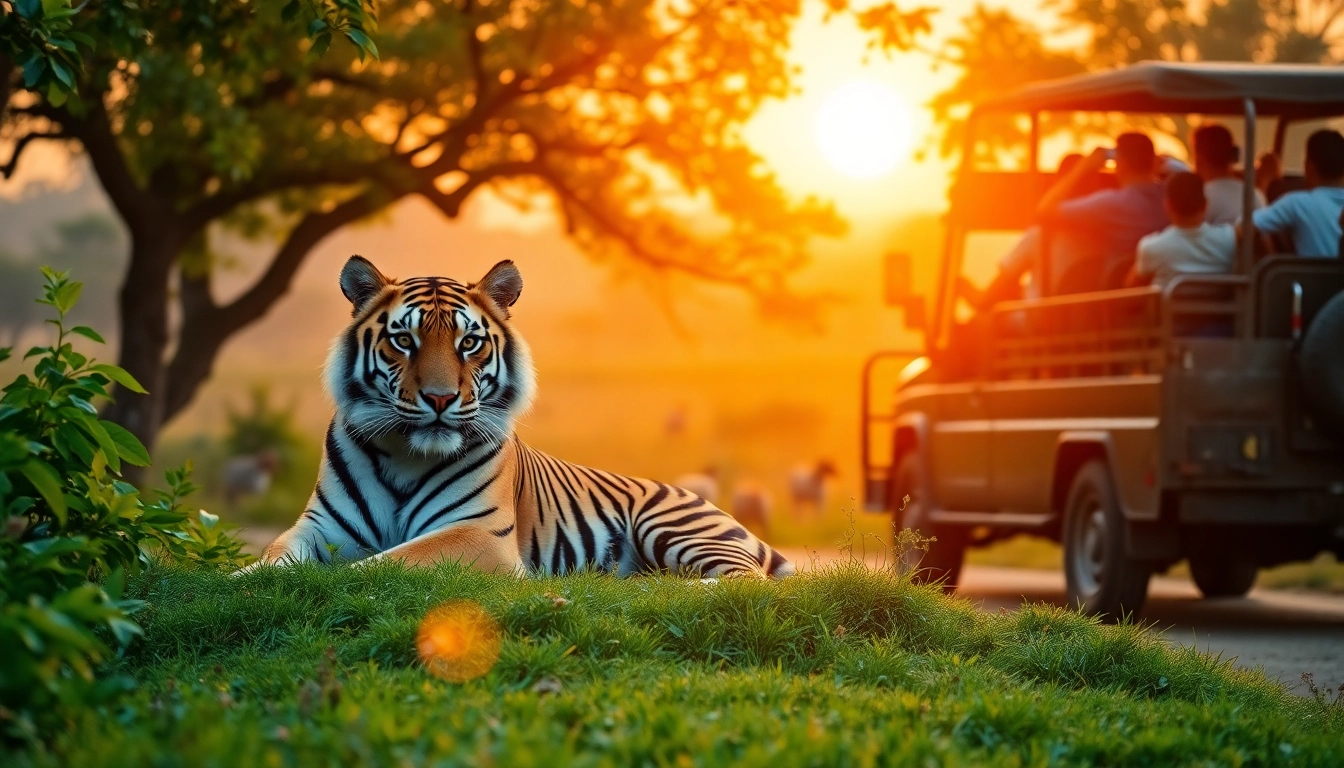Understanding Tiger Safaris and Their Importance
What is a Tiger Safari?
A tiger safari is an adventure tour focused on observing the majestic Bengal tiger in its natural habitat. These safaris take place in various national parks and wildlife reserves, primarily in India, where the tiger population is one of the largest in the world. During a typical safari, visitors embark on guided jeep or elephant rides through the dense forests and grasslands, providing ample opportunities to spot not just tigers, but also other wildlife such as leopards, deer, and exotic birds.
Why Choose Tiger Safaris in India?
India is home to approximately 70% of the world’s tiger population, making it an essential destination for wildlife enthusiasts. The Country’s diverse ecosystems — ranging from grasslands to dense jungles — provide habitats for these magnificent creatures. Moreover, the cultural significance tied to the Royal Bengal Tiger in Indian folklore and conservation efforts further enhances the experience, making tiger safaris not just a wildlife tour but also an educational cultural journey. For a comprehensive guide on tiger safaris, explore our overview of top best tiger safari tours.
Conservation Efforts and Their Impact
Conservation initiatives in India, such as Project Tiger, have significantly aided in stabilizing and increasing tiger populations over the years. These efforts focus on habitat preservation, anti-poaching measures, and community engagement to ensure that both the flora and fauna flourish. Visitors engaging in tiger safaris contribute indirectly to these conservation efforts as part of the revenue generated from tourism is often reinvested into protecting these habitats.
Exploring Top Best Tiger Safari Tours
Overview of the Most Popular National Parks
India boasts several national parks renowned for tiger sightings. Each park has unique characteristics that attract thousands of tourists each year.
- Ranthambore National Park: Located in Rajasthan, Ranthambore is one of the largest and most famous tiger reserves in India. Its varied terrain includes open grasslands, lakes, and ancient ruins that offer a stunning backdrop for wildlife viewing.
- Bandhavgarh National Park: Known for having one of the highest densities of tigers, Bandhavgarh is located in Madhya Pradesh and is characterized by its scenic hills and vast forests.
- Kanha National Park: Also in Madhya Pradesh, Kanha boasts a rich biodiversity and is famous for its successful conservation efforts. It is home to a variety of animals other than tigers, providing a well-rounded wildlife experience.
- Pench National Park: Similarly famed for its natural beauty, Pench is located on the border of Madhya Pradesh and Maharashtra and is known for its diverse flora and fauna.
- Corbett National Park: The oldest national park in India, Jim Corbett, is famous for its incredible biodiversity and is a prime location for tiger safaris.
Comparison of Different Tour Packages
When considering a tiger safari, different tour packages provide various experiences based on duration, accommodations, included activities, and attractions. Some of the popular tour packages include:
- Luxury Tiger Safari Tours: These often include stays in luxury tents or resorts, gourmet dining, and exclusive access to certain safari zones for premium wildlife viewing experiences.
- Budget-Friendly Packages: Designed for travelers on a tighter budget, these packages may include shared accommodations and group safaris, making them both economical and adventurous.
- Photography-Focused Tours: Geared towards wildlife photographers, these tours often provide additional opportunities for close-up shots and expert photography guidance.
- Family Safari Packages: Tailored for families, these tours usually offer kid-friendly activities alongside traditional safari experiences.
What to Expect: Itineraries and Experiences
The itinerary for a tiger safari can vary significantly based on the location and the tour operator. Most safaris typically last from a few days to over a week and may include:
- Morning and Evening Safaris: These maximize wildlife sightings as many animals are more active during these times.
- Nature Walks: Some tours offer guided nature walks that allow participants to learn about local flora and fauna.
- Cultural Visits: Interactions with local communities to understand their relationship with nature and conservation efforts.
Regardless of the itinerary, travelers can expect to gain insights into the complex ecosystem and the vital role tigers play in it.
Planning Your Tiger Safari Trip
Best Times to Visit: Seasonal Insights
The best time to embark on a tiger safari in India generally spans from October to June, post-monsoon. During this season, the wildlife sighting opportunities increase as animals tend to congregate around water sources. However, some specifics include:
- Winter Months (November – February): Ideal for pleasant weather and some potential glimpses of tigers.
- Summer Months (March – June): As temperatures rise, animals often venture out to drink at waterholes, making this the best time for tiger sightings.
Essential Gear for Safari Tourists
When preparing for a safari, having the right gear is crucial for a comfortable experience. Essential items include:
- Binoculars: For a closer view of wildlife without disturbing their natural behavior.
- Camera Gear: A good camera and lenses for capturing high-quality images, along with extra batteries and memory cards.
- Comfortable Clothing: Neutral-colored clothes that blend into the natural environment, along with sturdy shoes suitable for walking.
- Sunscreen and Insect Repellent: Protection against the sun and potential insect bites.
Booking Advice and Tips
When booking a tiger safari, consider the following tips to ensure a smooth experience:
- Research Tour Operators: Look for companies with good reviews and a proven track record in wildlife conservation.
- Check Residences: Ensure your accommodation aligns with your comfort expectations, from rustic lodges to luxury resorts.
- Plan Ahead: Popular parks often require advance booking, especially during peak seasons.
Maximizing Your Safari Experience
Photography Tips for Safari Enthusiasts
Capturing the beauty of wildlife can be challenging yet rewarding. Here are some photography tips for safari enthusiasts:
- Understand Animal Behavior: Learning the habits of tigers can help you anticipate sightings and better position yourself for the perfect shot.
- Use a Fast Shutter Speed: Wildlife is often on the move; a fast shutter speed will help you capture sharp images.
- Golden Hours: Early morning and late afternoon provide natural lighting that greatly enhances photographs.
Engaging with Local Culture and Wildlife
A safari is not just about observing animals; it’s also an opportunity to engage with local communities. Participating in experiences like village visits or local cooking classes helps foster a deeper understanding of how wildlife conservation schemes impact the livelihoods of nearby residents.
Understanding Animal Behavior
Knowledge about animal behavior can significantly enhance your safari experience. Engaging with guides who can share insights into tiger behavior and their ecosystem will provide a richer context for sightings. Being patient and observant can lead to extraordinary wildlife experiences.
Conclusion: Making Memories on Your Tiger Safari
Personal Experiences and Testimonials
Many travelers recount transformative experiences on their tiger safaris. From the thrill of spotting a tiger in the wild to serene moments under the stars, these stories highlight the unique touch of nature that draws millions to India’s forests every year. Testimonials often emphasize the knowledgeable guides who enhance the experience through their expertise and passion for wildlife conservation.
Post-Safari Recommendations
After experiencing a tiger safari, many visitors recommend sharing their stories and photos through social media or wildlife forums as a way to promote awareness about conservation efforts and inspire others to experience this adventure.
How to Support Wildlife Conservation
Travelers can contribute to tiger conservation in several ways, including opting for eco-friendly tours, respecting wildlife regulations during their safari, and participating in local conservation projects. Supporting sustainable tourism initiatives directly contributes to the protection of these extraordinary animals and their habitats.



